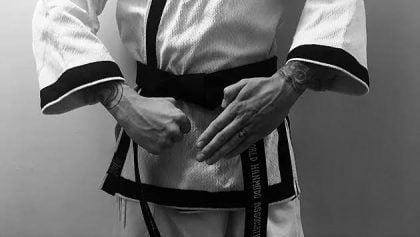Larry McDonnell is a martial arts practitioner, who was born with dwarfism. This has caused numerous orthopedic issues that limits his mobility. However, never one to back down, he fought for his passion in martial arts and made it work.
This is his interview case-study that will help you redefine your perception of physical limits, be it from disability or injury.
Larry McDonnell’s Interview – Martial Arts, Dwarfism & Overcoming Physical Limits
1. What do you train in? And how long have you been training for?
I first started out with Okinawan Shorin Ryu in May of 1999. I have a 2nd-degree brown belt. After the local Shorin Ryu class shut down due to unforeseen circumstances, I moved on to training in Ju-jitsu (Japanese version). I got all the way to purple belt in Ju-jitsu. Earlier this year (2016) I began training in Shotokan along with my kids. I have dabbled in a few other styles such as Tang Soo Do and Tai Chi.
2. What’s your purpose and vision for training? What do you want to achieve?
Martial arts have always fascinated me since I was a child. I remember when I was younger I asked if I could take a karate class. I was told no because it would be too hard for me since I am disabled.
I am a Diastrophic Dwarf with skeletal dysplasia. I have a whole list of orthopedic issues that have resulted in limiting my mobility. I figured getting into a karate class could help me.


Not taking “no” for an answer
I never liked being told I couldn’t do something because they (parents, family, doctors, and nurses) didn’t think I could do it. I knew what I was capable of doing. I wanted to prove people wrong and that I was capable of anything when I put my mind to it.
My parents wanted to know the purpose of me wanting to get into karate. One of the reasons I told them was that I wanted to lose weight. Mom said, “start walking, you lose weight that way.” At the age of 17, the thought of walking was boring. If I wanted to walk I would join Frodo and Sam in taking the ring to a volcano. Karate – well it looked more fun.
Gaining benefits in mobility
At first, I didn’t realize how much I would benefit from practising karate. Initially, I lost some weight and I gained some mobility. What I hadn’t counted on was the fact I kept myself from needing a hip replacement in my mid-20s. Most little people who had hip and knee alignment as children usually had to get their hips replaced in their mid-20s. My doctor looked at me and told me that I am one of a few people who finally get it. He did all of the work on my legs, hips, knees, and feet so I could go out and live life to the fullest. My doctor told me that he has operated on other little people who would go home and sit because they were afraid to use their legs.
Having fun and meeting masters
I still practice martial arts for the fun of it. I also practice it because I feel better after a good workout. As I have gotten older, my goals have changed. Now I want to learn as much as I can. Not just from one style but from many. There are also many people I would like to work out with and learn from such as Doug Marcaida who does Kali and is awesome with the knives. The Ninjutsu master Masaaki Hatsumi from Japan and Yossi Sheriff from Israel have both fascinated me for years. I would also like to work out with Jesse Enkamp from Karate By Jesse and the legendary Master Ken from Ameri – Do – Te. There are many others but you get the idea.
3. What got you into training and who are your inspirations?

As a child I was inspired by a lot of movies and television shows featuring martial arts and most of all Ninjas! I grew up being fascinated with ninjas. I also enjoyed watching the Mighty Morphin Power Rangers, especially when they were in their ninja mode. I know it seems lame but I don’t care. I will probably go see the new movie when it comes out. I also enjoyed staying up late hanging out with my former brother in law (karate buddy) playing the video game Mortal Kombat. Yes, you guessed it; I was usually the Sub-Zero or Scorpion (the ninjas). If we weren’t playing video games we were watching Dragonball Z.
Speaking of former brother-in-law, I would have to give some credit to my sister for helping me get into martial arts. Her first husband had a red belt in Tang Soo Do. She had an idea of what to expect in a martial arts class. She advocated to our parents on my behalf to let me go to a karate class.
4. What are some responsibilities you have that compete with training time? How do you make training work?
When I was younger and I first started practising martial arts, my biggest responsibility was to get through high school. I would go to school then go do karate class. Life was much simpler before turning 18 years old.
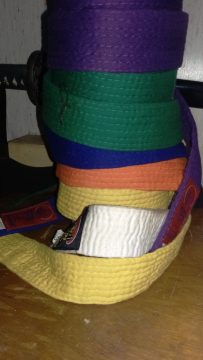
Now I am 34 and I have to be an adult and do adult things. Adult things such as go to work and pay mortgages. I don’t get to train as often as I would like now that I have responsibilities. I do try to make the best of it. I train when I can. When I am at work I can be seen in the hallway going through a kata. At home, I’ll run through some blocks, punches, kicks and a few other drills. I have 3 kids and occasionally all of them will attack me on at the same time.
If I cannot train physically then I meditate and I run through my katas. I sit, I close my eyes and visualize myself punching, kicking, and blocking. I visualize the attacks and the counter to the attacks. I review and analyze each technique to see if it can be applied in a different manner. I ask questions; is this a block or is this actually a strike?
I may not be learning through physical motion but I can continue to learn principles, theories, and philosophy.
5. Are there any challenges you face training as a little person? Please share examples of how you overcame those challenges.
You know in the movies how Jean Claude Van Damme can jump up in the air and kick someone across the face? Well for obvious reasons I cannot jump up into the air that high. So in order for me to kick someone across the face like he does, here is how I perform this technique: I take their legs out from underneath of them causing them to fall to the ground. As they are lying on the ground I get close to their face – and I kick them. Just kidding.
Nearly passed out
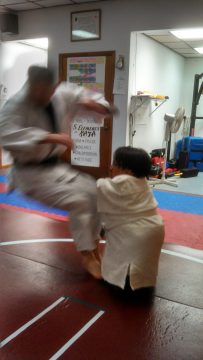
On a more serious note, there are some things I have found to be challenging. one of the things I have learned is that I cannot chase an opponent. Unfortunately I had to learn this the hard way. A few years ago (around 2010) I had gotten a lung infection. To be honest I thought I had a small cold. I thought that if I worked out and worked through it I would feel better. So I went on to class. During the last 30 minutes of class, we started sparring. Everyone had sparred at least 1 round with someone, except for me. Since there were an odd number of students in the room, the instructor said he would spar me so I could have my turn.
My instructor was a 4th-degree black belt. He is very light and fast on his feet. I had received my second-degree brown belt rank a few months before. At this point in my life, I was approaching 110lbs. Keep in mind 110lbs is not good for someone who is 3 feet tall. I already felt like I had a slight cough and cold.
I vaguely remember sparring. I know my instructor moved around a lot on the floor. I went after him everywhere he went. He moved to the left, I ran as fast as my little legs would take me so I could get to him. Before I could get there he had flanked to the right. I would finally catch him, or he felt pity and let me catch him. I remember the burning in my muscles. I almost passed out several times because it was difficult to breathe. I remember my vision fading once while I was trying to land a punch on him.
Realisation
Soon afterwards, (a few years later) it dawned on me that I would not go after the fight. I would let the fight come to me. I would stand my ground. I decided I would stick to the same principles as the front punch. Only go as far as the length of your arm to throw your punch. Do not give any more than that for you will run the risk of throwing yourself off balance or open yourself up for an attack.
In 2013 I started practicing Ju-jitsu. Once I got comfortable with myself in the class I began sparring. I decided I would try my strategy. I let my opponents come to me. Of course, this is much easier to do in ju-jitsu since you use your opponent’s energy against themselves.
6. How have you and your martial arts instructor adjust your technique and was there ever a concern for effectiveness? What did you do about it?
Karate
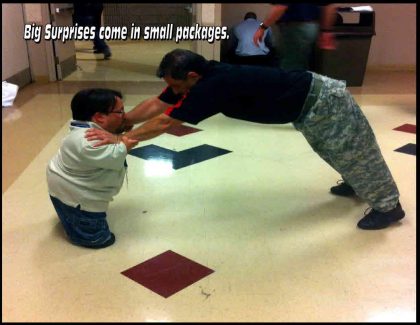
The first day of karate the instructor thought he would wear me out and I would never return afterward. The second day when I returned – the instructor knew I was serious about learning and practicing martial arts. My sensei knew there were techniques I would never be able to do for obvious reasons. Sensei could also sense that I had a decent head on my shoulders. So he decided that when it came to a technique that I cannot perform, I would still learn the teaching points. He wanted me to focus on learning the concepts, the principles, philosophies, and the smallest details about techniques and katas. My focus would be on becoming a teacher/sensei/instructor.
Ju-jitsu
Years later I went with a friend to observe a ju-jitsu class. As I sat there I began to have reservations about practicing the style. I watched as students threw each other around the room. I decided to give it a try anyway. Starting with my first day of class the instructor showed me how to perform a particular throw. Before I could protest and say “I don’t think I can do that” the instructor explained to me that there was a modified version of the throw. He showed me the modified move. I thought to myself – I just might be able to do that. I practiced the modified throw.
My ju-jitsu instructor knew how to modify several techniques. If we came across a technique that would simply be impossible even if it was modified; then the instructor performed the technique on me and taught me how to counter it. Even though there were some techniques I could not do, I would still take the time to learn the teaching points. Taking the time to learn the teaching points helped me a few months ago as I walked a lady through the basics of an Uchi Mata.
7. Was there a time when you nearly gave up on training? What made you persevere?
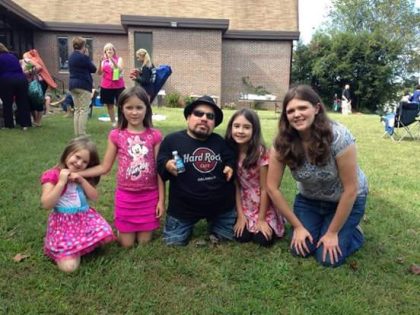
I cannot say that I have given up on training, practicing, or learning. However, there are several factors on why I have taken an extended leave of absence from a dojo over the years. Some of these factors are various types of responsibilities I must see to and practice martial arts at a dojo has to go on the back burner.
Family responsibilities
In my earlier years of practicing karate, I would spend time with some of my classmates (approximately 10 people or so) after class had ended. It was nothing to walk out of the building at 8:10PM and stand in the parking lot for 20 to 40 minutes talking. Sometimes we would go to the nearest restaurant and get dinner while we continued whatever discussion we started in the parking lot. There were some nights I would come home from class very late at night.
Shortly after I got married I started practicing at a new dojo. Many of my classmates from my earlier years were at this dojo and some things never changed. After class, we all proceeded to go outside to the parking lot and talk for 20 to 40 minutes.
I got home and my wife gave me the look as I walked into the door. She said it was almost 9:00PM and the dojo wasn’t that far from the house and wanted to know why it took so long to get home. I explained that we all stood around and talked for a while. I said didn’t see the harm in standing and talking to classmates and that they did it all of the time. I also told her I did it when I was younger.
She looked at me and asked, “Do you know the difference between you and your classmates?” I said no. She went on “All of your classmates are divorced and have no one to go home too. You do! You have a wife and kids!”
Ever since that conversation I had with my wife I have made it a priority that family comes first then martial arts. So if my child or wife is sick I stay home and help take care of them instead of going to class.
Educational responsibilities
Martial arts is more about using your head than it is punching, kicking, and blocking. I have no problems taking time out of the dojo to work on a bachelor’s degree or master’s degree. Especially, since I am paying a lot of money for said degree. I feel the more education you can get the more it can help you in martial arts. Taking time to focus on education will only make me a better warrior.
Financial responsibilities
Financial responsibilities, need I say more? If I cannot pay my bills I cannot pay the sensei. Nor can I pay to get the gas (petrol for you international readers) in the car to go to class.
Dojo politics
I do not like being told I cannot do something because I am disabled. I have shown that I will go above and beyond to prove that I can do something despite the fact I am disabled. I definitely do not like it when people tell me I cannot be friends with someone. I won’t go into too much detail but I will say that I was told I shouldn’t be someone’s friend because it was bad for their business. When I heard that, it was everything I could do not to take off my belt and handed it back to them.
Goals and interest are no longer aligned
I spent a few years at a dojo and I was constantly learning. I would go to the 2-hour class and I worked out non-stop. Every class I went to I had something new to use in my plethora of martial skills. After a year and a half the lead instructor decided he needed to focus on his responsibilities to his family and career. He needed to be closer to his home to take care of his family. He would also be spending more time out of town. So the time he was home, he wanted to be with his family.
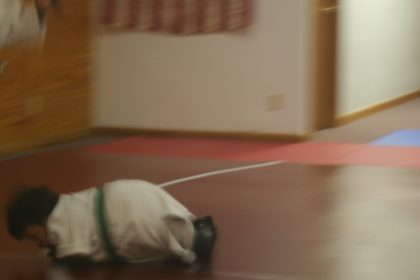
The assistant instructor began to take over class more frequently. Keep in mind this assistant instructor was very talented as a martial artist and wanted to learn as much as he could about the style. His method for learning more was sparring in tournaments with people he didn’t know. He began to focus more on the upcoming tournaments in the surrounding area.
I noticed after a few weeks I was going to class and not getting a full workout. Eventually, I got 10 minutes of a solid workout. Afterwards, I sat on the side of the room while the assistant instructor would talk about tournaments and practice various techniques. I eventually got bored. I realized I had to take care of some responsibilities at my own home, the decision to stop going to class was easy. Though I do not think my departure will be permanent. I do plan to go back in the future. Until then I wish the best and I hope the assistant instructor who is now the lead instructor is doing well.
8. What advice would you give people with some form of physical limitation, who want to train in martial arts but are afraid to make the first step?

The hardest part is walking through the door. Once you get across the threshold, the rest is easy. Do not be afraid to go in and check out the class. If you are curious, just sit there and observe. Ask questions. Do not hesitate to try out some of the moves. Do not be discouraged if you cannot get it right away because no one gets it on the first try. You have nothing to lose by going into the dojo and trying.
At the end of the class, you learn one of two things: you can do it or you can’t do it. All that matters is that you tried. You do not want to be 80 years old sitting in your room staring at the wall thinking to yourself “I should have tried it!”
9. What advice do you have for martial arts and fitness instructors who are teaching people with physical limitations?
An instructor should have patience. They need to have the ability to think outside of the box. Don’t be so rigid that you cannot modify the technique. Tradition is good to remind you of the past. But tradition can keep you from going forward if you are not willing to adapt and evolve as the environment changes. I have had issues where an instructor insisted I perform a move the traditional way and to modify it was wrong.
10. Lastly, what does your website Karate Kickin’ Dwarf mean to you and what do you hope to achieve by sharing your experiences?
I chose the name “Karate Kickin Dwarf” because I hope it would catch people off guard or make them raise an eyebrow and intrigue them. “The Little Person who does Karate and Jujitsu dot com” just didn’t have a zing to it. Even saying it out loud I get bored.


Entertaining & inspiring people

My goal for the website is to entertain and inspire people. I also wanted something out there in the world for people who are interested in practicing martial arts, no matter if they are disabled or not, will see this and say “oh, well if he can do it, so can I.”
When I was younger I tried to do research on the internet (before the days of Google) to see if there were other little people doing martial arts. I wanted to show it to my mom and dad that if they could do karate, I could too. I wanted some supporting evidence so they would let me go to a class.
A few months ago I received a note from a father who found my website. He told me that his child was a dwarf and he was doing research to see if it would be alright for them to practice martial arts. He said reading about my experiences helped him make a decision. I was elated to read that my website had helped someone.
Advocacy for the disability community & helping restore mobility
I plan to grow my website. I have more ideas of what I hope to accomplish. I know it will take me a while since it is just me at the helm. However, I would eventually like to do more interviews so I can meet some of the renowned martial artists in this world. I would like to offer a consulting service to help other martial artist using my wide range of professional and personal skill sets.
Perhaps I can use this as a way to be an advocate for the disability community. Maybe create online training videos that focus on low-impact movement while at the same time restoring people’s mobility. I am also open to the idea of going around the world doing motivational speeches and demonstrations.
Editor’s Note: Interviewing Larry McDonnell
Broaching the topic of disability
Although I interact with Larry on social media occasionally, I was afraid that my questions about disability would cause offense. He assured me that he didn’t mind questions with no ill-intent and would correct me if I crossed the offensive line unintentionally.
Very often, we avoid talking about disability so as not to cause offence. Yet, by avoiding the topic, we lose the opportunity to learn from and connect with our fellow human beings. I have to thank Larry for his candour and enlightening responses.
The mindset to overcome physical limits
Also, in exploring Larry’s journey in martial arts as a little person, his responses highlights the underlying mindset in overcoming physical limits.
Instead of accepting that a technique cannot be done due to physical limits, find out how you can make it work for you. After all, it isn’t physical limits that holds us back in our goals, but our self-doubt and unwillingness to get out of our comfort zones (including being laughed at and criticised by doubters).
No one and nothing should have that kind of power to prevent us from achieving our goals.
Common goal among ninjas
Lastly, I wanted to know what defined Larry as a person and martial artist. Little did I expect to find out that both Larry and I share the common goal of bringing martial arts and mobility to people.
On this note, please visit my fellow modern-day ninja’s – Larry’s website for more – Karate Kickin Dwarf.


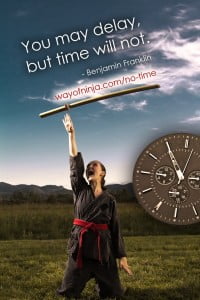
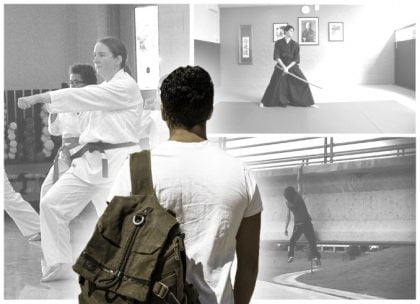
![Karate Training in Okinawa, Japan – Jesse Enkamp [Interview]](https://www.wayofninja.com/wp-content/uploads/2017/10/Jesse-Enakamp-420x211.jpg)

